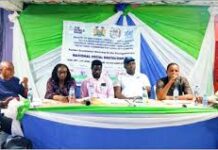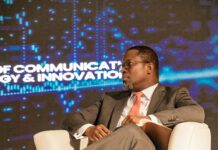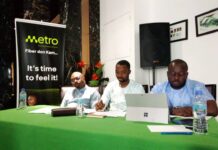By Talleyrand
The interior design of the Kaabhatullah Masjid in Aberdeen, West of Freetown
Islam and digitalisation are often at work in the Middle East parts of the world. In Sierra Leone, Islam came to the country from the North were the Susu, Madina and Fullani ethnic groups from neighbouring Guinea as settled for centuries and were exporting the religion to other parts of the sub-region of West Africa and entered Sierra Leone in the 15th Century AD.
Since then a widespread of the faith as engulfed many Sierra Leone stretching from the North to the South and East, and Western parts of the country. Today, Muslims account for 75% of the Sierra Leone population wit barely 20% Christians and 5% atheists or non-religionists.
Inspite of the soaring number of Muslims in the country and mostly educated as well due to their population size and density, yet the fait ad not embraced digitisation as in other countries. In the midst of this digital gap, a difference has been made by one member of the Islamic faith in Sierra Leone that has decided to go digital. This brings to light the Kaabatullah Masjid in Aberdeen, West of Freetown.
Religious cleric making a statement during the Commission of the mosque
The masjid resonates with the fact that the fact that the study of digital religion examines the influence of religion in the new media have upon one Muslim and another. In recent times, the media have paid increasing attention to the religious uses of social media. As the Internet has become embedded in our everyday lives, digital media increasingly informs the practice of religion, the things adherents do to enact their beliefs and express religious identity, to demonstrate their affiliation with a religion or religious community.
The Kaabatullah Masjid in Aberdeen opened on Sunday 19th March examines the ways the Islamic faith in Aberdeen is practicing religion with digital revolution. By looking at the ways and means the Islamic faith was being practiced, the Aberdeen Aku Muslims have made an innovation to erect and digitalize the house of Allah through social media in order to identify how Islam highlights some of the common forms of religious practice that can be found online.
The media and the political class graced the occasion as Ibrahim Babatunde Sesay of Satellite Newspaper (left) poses wit Sierra Leones Vice President Dr. Mohamed Juldeh Jalloh (right)
Many religious scholars that came from various parts of Freetown and other countries including the head of Aku Muhammadan in The Gambia pointed to the reality that the Internet is increasingly essential for many Islam. Artificial intelligence promises to revolutionise many aspects of the Internet, and this was already taking place in Sierra Leone with Kaabatullah Masjid being on social media with its own Facebook, Instagram, Twitter and all other social media handles.
However, the conservative nature of Islam over the time as caused inner rapid pressure upon Islam being practiced or open up to the emergence of artificial intelligence which was lagging behind considering its human rights implications.
Religious identity is part of people’s self-presentation on social media, and at times this kind of media offers a safe platform to do so when its users (Muslims) who are mostly the majority (75%) in Sierra Leone, would help them improve their religious identity online, by which means members of the faith would be involved in behavioral change by conducting religious ceremonies, thoughts and demands that are adaptive to their religious beliefs.
Traditional authorities and government dignitaries including the Vice President of Sierra Leone Dr. Mohamed Juldeh Jalloh that graced the ceremony sourced out that digital information was key to advancing religious identity and rights in Sierra Leone and this could change the face of Islamic worship in a better way than traditional methods that have formed an opinion in the past.
It would be recalled that the Kaabatullah Masjid was erected by the Aku Muslims of Aberdeen in West of Freetown. These people have existed in the West of Freetown, mostly settling on the seaside of the city since the 1800s. They migrated from Nigeria and Gambia descent and settled in Murray Town and Aberdeen Community. History dates tat their first settlement was Watson Street after the Davies Family, the first Christian community that settled there offered them a house for prayers at Kincardine Street as an assembly point to pray on normal times and sometimes for Eid Prayers.
Population density of the Aku Muammadans or Muslims continued to increase each year and tis was also incumbent on the hosts such as the Davies Family to reconsider more assistance to the strangers by giving them another piece of land were the first Madrasa was built to teach Islamic education that later became the Aberdeen Amalgamated Primary School. The legacy today stands erect in a modern structure since 7th May 2017. In addition to their assets of the Akus of Aberdeen, the two cemeteries of Jonson Street and Pkapaordun were donated to them by the Aberdeen Christians.
On this background, digitalization has now strengthened the bond between the Aku Muslims and the rest of Sierra Leoneans. The world of Islam can be seen today through digital transformation provided as an opportunity by the vast transformation of the Aku Muhammadan Muslims.
e study
AU2
of digital religion examines the influence religion and new
media have upon one another. In recent decades, scholars of media and
religion have paid increasing attention to the religious uses of new media.
As the Internet has become embedded in our everyday lives, digital media
increasingly informs the practice of religion, the things adherents do to
enact their beliefs and express religious identity, the things adherents do to
demonstrate their affiliation with a religion or religious community. This
chapter examines the ways religious practice occurs within digital
environments through the lens of religious ritual online. By considering
the particular meanings and ways rituals are enacted through media, we
identify how religious ritual highlights some of the common forms of
religious practice found online.
The study
AU2
of digital religion examines the influence religion and new
media have upon one another. In recent decades, scholars of media and
religion have paid increasing attention to the religious uses of new media.
As the Internet has become embedded in our everyday lives, digital media
increasingly informs the practice of religion, the things adherents do to
enact their beliefs and express religious identity, the things adherents do to
demonstrate their affiliation with a religion or religious community. This
chapter examines the ways religious practice occurs within digital
environments through the lens of religious ritual online. By considering
the particular meanings and ways rituals are enacted through media, we
identify how religious ritual highlights some of the common forms of
religious practice found online.
26 1 Introduction
27 Digital religion is an area of research that has received increasing attention in the last
28 three decades, focusing on the relationship between religion and new media. Over
29 time, this area of study has evolved from early efforts to document the emergence of
30 “cyber-religion”, or how religion was being integrated into the then new environ-
31 ment of cyberspace (Campbell 2013). While cyber-religion initially served as a
32 useful term for “[exploring] and [calling] into question traditional assumptions and
33 understandings of religion as it engaged with new cultural and technological con-
34 texts,”Campbell notes the expression constituted an “amorphous”concept that
35 “often evoked assumptions that it was based on an incomplete or somehow false
36 form of religiosity.”(Campbell 2013, p. 2). Early studies of cyber-religion, like
37 O’Leary’s investigation of the rise of Wiccan religious practice in online discussion
38 forums, sought to document and validate the variety of ways religion was imported
39 into various digital environments (O’Leary 1996). The study of religion and the
40 Internet soon progressed, introducing the terms religion online and online religion as
41 a way to distinguish between existing religious practices entering into online spaces
42 and new religious forms emerging through online practice (Helland 2013). While
43 these terms offered a useful distinction between traditional religious practices being
44 imported online and how the digital environment created opportunities for new
45 religious manifestations, they tended to over-simplify the distinctive forms of reli-
46 giosity appearing on the Internet as religious adherents increasingly integrate online
47 and offline spiritual lives.
48 More recently Campbell has suggested “digital religion”as an alternative
49 description useful “to work that investigates the technological and cultural space
50 that is evoked when we talk about how online and offline religious spheres have
51 become blended and integrated.”(Campbell 2013, pp. 3–4). Digital religion scho-
52 larship like Cheong and Ess’study of microblogging rituals, highlights what is and
53 isn’t unique about the ways religion is constituted through digital media (Cheong
54 and Ess 2012). Scholarship in digital religion examines a variety of themes, from
55 questions of identity and authority to community, authenticity, and ritual, conside-
56 ring how each area is influenced by online context. While each of these certainly
57 warrants its own discussion and is of considerable importance to this interdiscipli-
58 nary field of inquiry, ritual is perhaps the most relevant feature of digital religion for
59 our discussion here, as it underscores the distinct social practices of digital religion.
60 Furthermore, rituals shape the way adherents and communities negotiate religious
61 identity, authority, community, and understanding of authenticity through their
62 religious practices.
63 In this chapter, we describe the ways religious practices are performed online
64 through specific digital ritual, to demonstrate the various ways, shaped by digital
65 spaces and digital media, people “do”religion or connect with the sacred. To help
66 understand what is and is not unique about ritual in digital religion, we begin by
67 considering the ways scholars have previously approached ritual in offline contexts.
68 Then, we look at examples of how scholars have examined religious rituals with and
69 within new media. From here, we can see how ritual in digital religion connects



































